Eldar domination: hands-on with Dawn of War 3's space elves
Watch your backs, Space Marines.

This article was originally published in PC Gamer issue 300. For more quality articles about all things PC gaming, you can subscribe now in the UK and the US.
A few squads of burly Space Marines, members of Dawn of War 3's Blood Ravens Chapter, are hanging around a communications device, probably swapping tips on the best oil to use on their bulky armour. Little do they know, right next to them, Eldar are gathering. Cloaked warriors hide in the open, while the rest of the army lingers in the tall grass, essentially invisible.
Before the Marines have time to ask "Who is that running toward us?" one squad of them is already dead, sliced and diced by a dashing Eldar who moves with preternatural speed and grace. The second squad opens fire, only to be sniped by the previously invisible Rangers and the infantry in the grass. The final group, maybe because they’re smart, or perhaps they’re just cowards, run for it. Farseer Macha, the leader of this band of hunters, tosses her Singing Spear at their backs. Those who don’t die instantly fall a second later, as Macha recalls her magical weapon and it cuts through them once again.
If the Space Marines are Dawn of War 3's crushing hammer, the elegant Eldar are its scalpel: efficient, precise, and often subtle. I’m a lot more intimidated by the scalpel. Also that boomerang spear.
While the previous games focused on the Space Marines, leaving the other factions to muck around in Skirmish mode until they got expansion campaigns, the third game’s campaign jumps between the Space Marines, Orks and the Eldar, as they race to claim a superweapon hidden on a frozen world. For the Eldar, it’s not just a race for a weapon, though; it’s a race for survival itself.
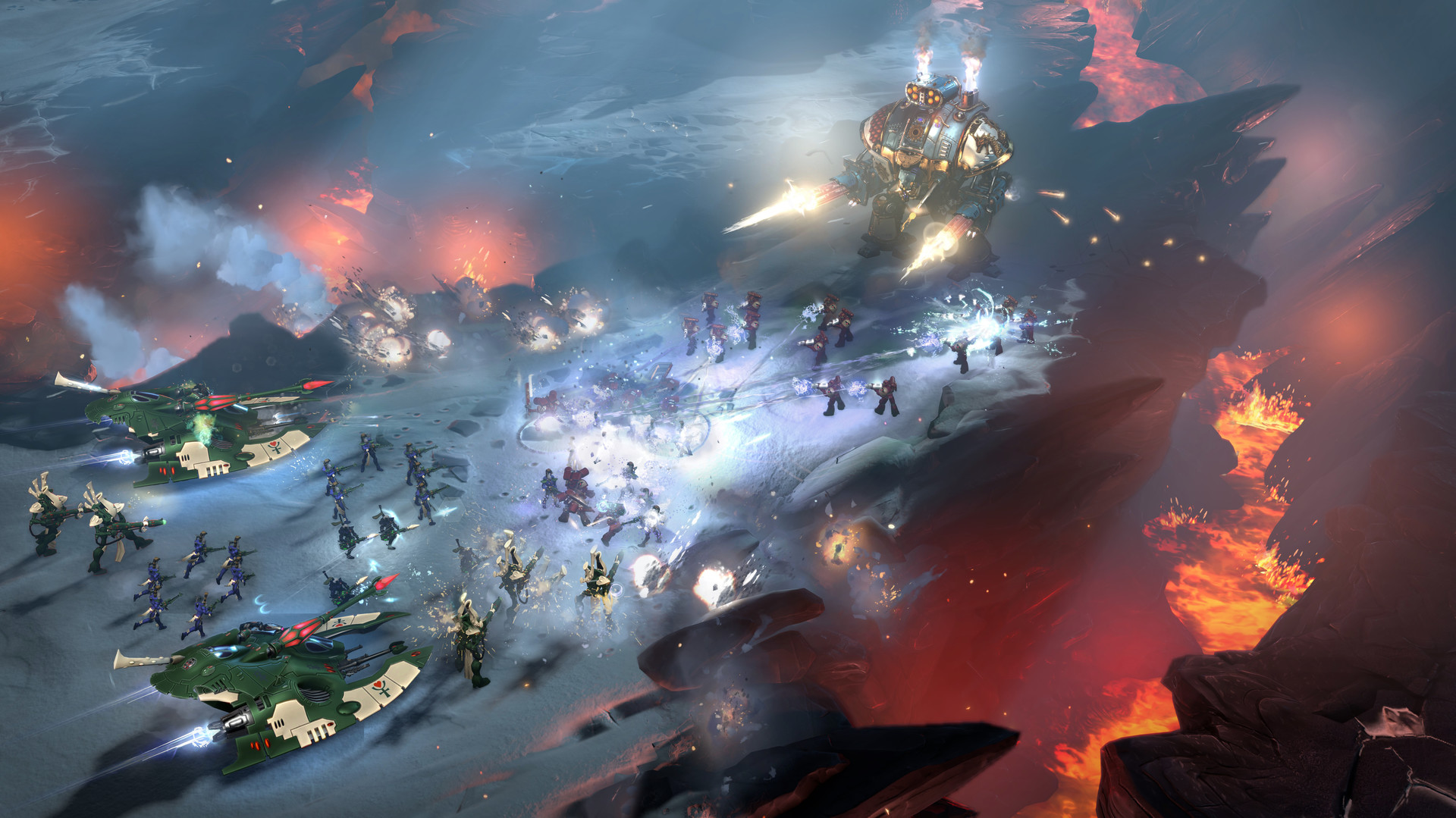
"The Eldar are sort of the origin of the story," game director Phil Boulle tells me. "There’s a prophecy that there’s this mysterious planet, Acheron, that emerges from the Warp every 5,000 years or so, and on it is meant to be the Spear of Khaine, the weapon of their war god. They believe that it will be able to reignite the Eldar, bringing their species back from the brink. Our protagonist, however, Macha, she’s got her doubts about this prophecy. She represents the player’s cynical view. She’s the voice of reason."
Unfortunately, Macha’s not in charge, and must bow to the demands of her zealotic superior. In the Eldar campaign mission Relic fired up for me, set on the world of Cyprus Prime, Macha’s been ordered to assassinate her enemy-turned-friend-turned- enemy, Gabriel Angelos, to stop him from reaching Acheron, and thus end his quest for the spear. Like the Space Marine mission that we’ve already played, there are multiple objectives, some optional, several enemy bases, and lots of pesky reinforcements and patrols that necessitate protecting your base as well as hunting down foes. But the focus, at least at the start, is on stealth and fast strikes, encapsulating what sets the Eldar apart from the other factions.
The biggest gaming news, reviews and hardware deals
Keep up to date with the most important stories and the best deals, as picked by the PC Gamer team.
Cause for alarm
Dotted around the appropriately battle-torn and gloomy map are resource points and communication towers, all guarded by Space Marines. The former are obviously important because you need to fund the war machine, while the latter are the first primary objectives. The wrinkle? Each of these points has an alarm, and if a Space Marine squad manages to call for help, reinforcements will rapidly show up. The trick, then, is to get close without being spotted, and take out either the alarm itself, or anyone who’s running to activate it.
I confess that, on my first go, I largely failed to do this, instead contending with the additional enemies. This didn’t stop me from claiming victory in the end, but it did cost me squads that might have otherwise been saved. Feeling more confident, I experimented a little when I took the mission for another spin, and managed to take out all but one alarm. Like most fights, it was my units’ flashy special abilities that were key.

While sheer numbers can win some brawls, it’s these extra-powerful attacks that have the might to turn the tide of a battle. They range from simple plasma grenades to situational combos that can decimate entire squads, and then some. Farseer Macha’s boomerang spear is one of those. You activate the ability, launching her spear and impaling a row of very surprised enemies. With them dead, you reposition, preferably putting another batch of victims between Macha and the spear, before activating the ability again, recalling the now very bloody weapon. While it’s stuck in the ground it can buff allies, but it can also be made to explode with psychic power, as spears are wont to do.
The visual impact of these abilities reflect their strength, so the more powerful ones are presented with more flair. Conveniently, there’s also unit priority when you’re commanding a group, so the unit with the strongest abilities will remain your primary unit, allowing you to use their hotkeyed powers even when you’ve selected a dozen other troops.
Since the number of troops in Dawn of War III is so much greater than in its predecessor, the attacks, particularly those belonging to Elites like Macha, are free to have a much larger effect. The cooldowns are also fairly quick, and it was rare for me to select an Elite and discover that I couldn’t do anything. The result: fantastic momentum. The action is frenetic and the battle lines are always shifting. That’s why cover has completely changed, too. "We moved to larger armies, larger squads, with the camera pulled out, and it’s a lot more finicky if you have to line them up along walls," Boulle explains.
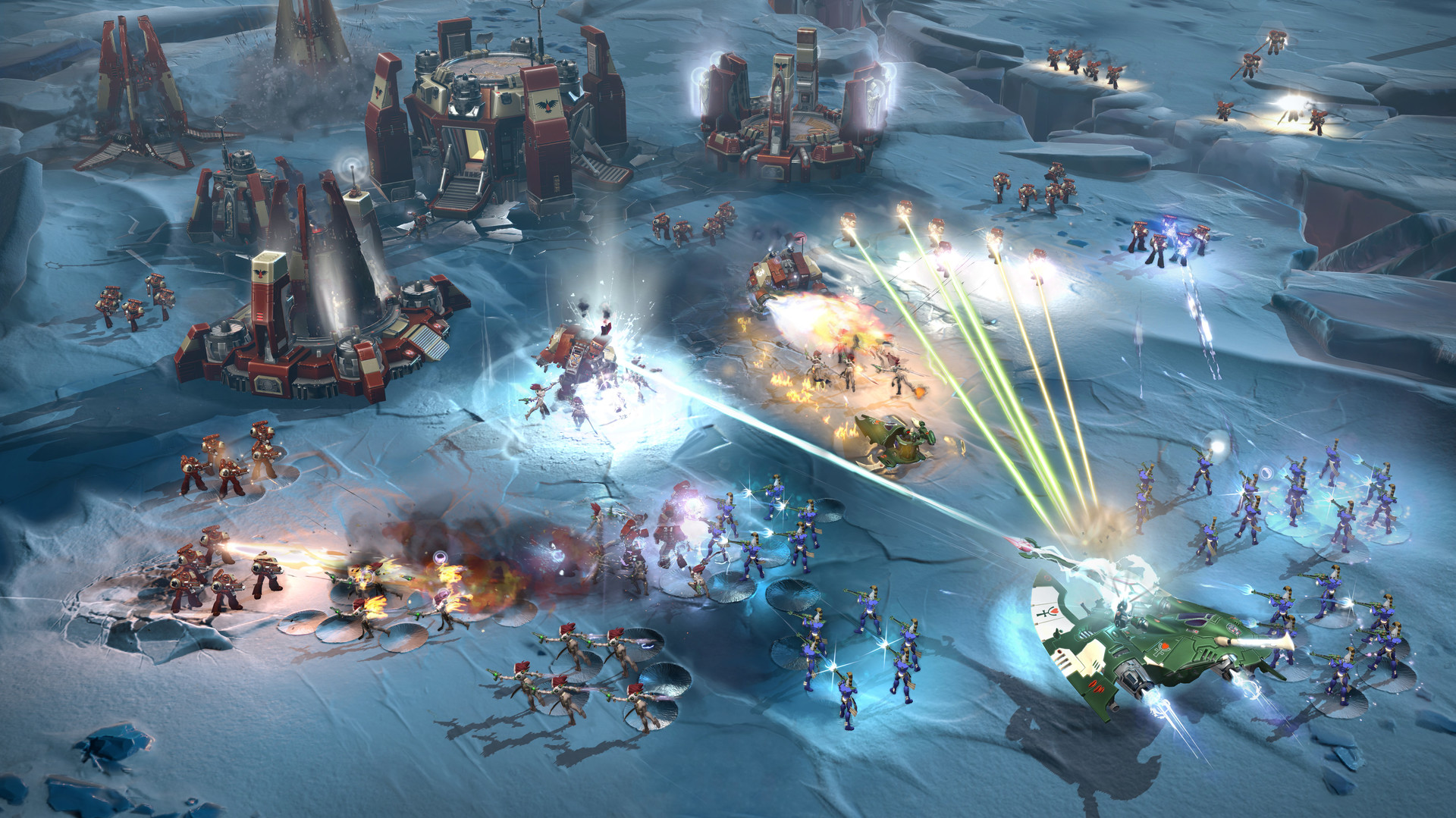
He adds: "The other thing was clarity, one of our huge mantras. Directional cover is clear as long as you’re close enough to understand who is on what side of a wall, for example. When your camera is pulled out, it becomes a lot harder to tell.
"That’s why we came up with the shield bubbles, which work similarly to buildings in Dawn of War II. You’re either in them or out of them, and when you’re in them, you don’t take damage, but the bubble does and can be destroyed. The final reason, and ultimately the most important reason, was to give an important role to melee units. With bubbles, enemy ranged units just can’t go in them at all. Melee units can go in, so it makes them much more central to how you play because they’re your storming units."
While the Space Marines like to leap into the fray, a tactic typified by the jetpack-sporting Assault Marines, the Eldar are a little more fragile, relying on hit and run tactics, shields, and no small amount of precision. Getting into prolonged battles is very dangerous. At the mission’s climax, I found myself besieging the Blood Ravens’ fortified base in the hopes of drawing out my target: Gabriel Angelos. By this point, I had a veritable army, diverse and battle-tested, and I’d just mopped the floor with the last group of Marines. I was cocky, is what I’m saying.
On the first push forwards, I lost half my army.
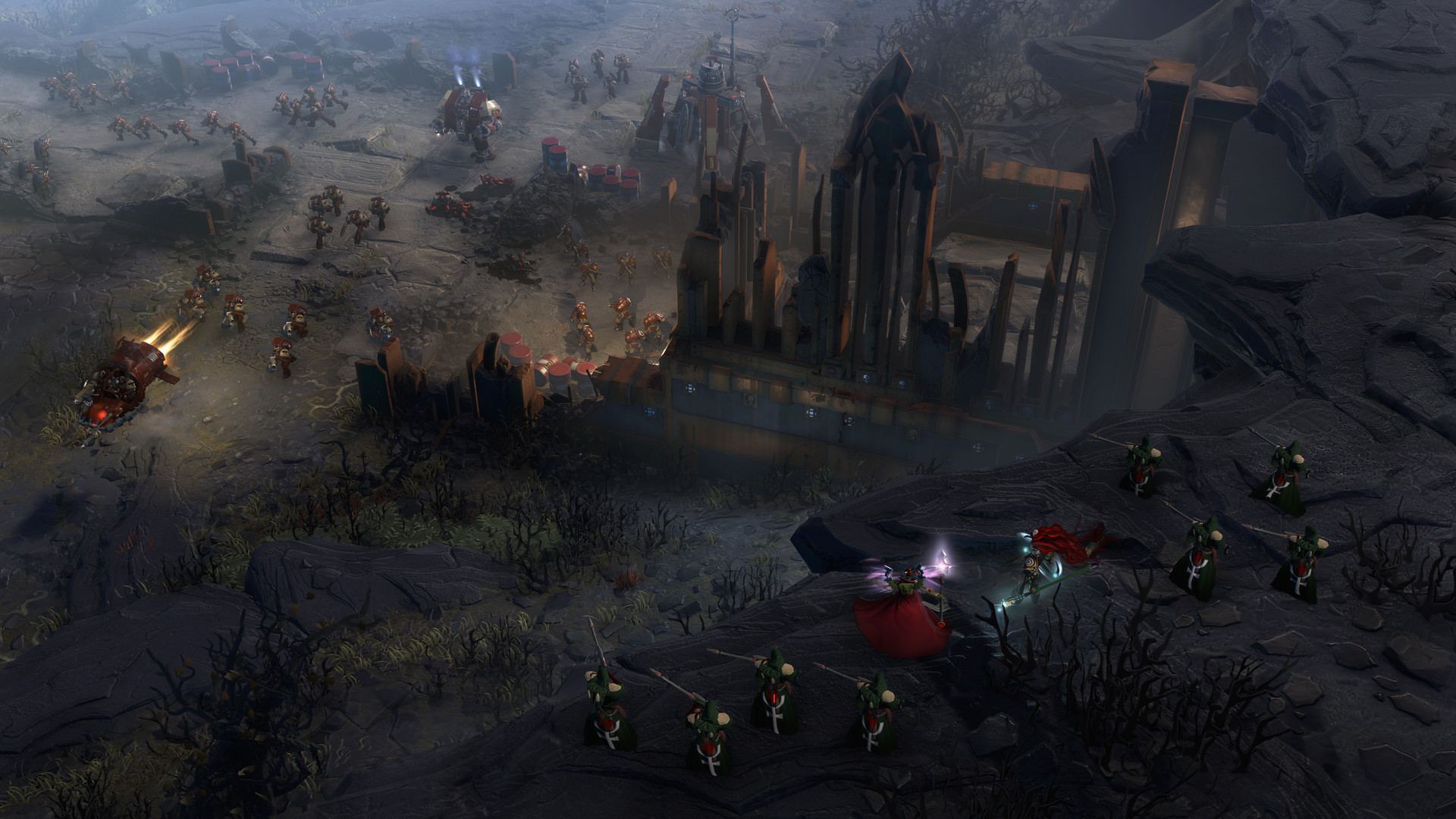
A siege needs a battering ram, I thought, so I gathered every unit and just charged. The plan was to disperse when we got into the base, but there wasn’t even time. As my valiant Eldar warriors got to the top of the ramp leading up to the battlements, they took out the sentries huddled underneath an energy dome, and then the Whirlwind happened. From its distant position the tank unleashed its devastating payload, annihilating everything in the blast zone. My floating anti-vehicle Shadow Spectres, my beloved Falcon troop transports, my big, sexy Wraithblades—all gone.
The other half survived in large part thanks to Wraithknight Taldeer, another Elite unit. It’s a massive mech, housing twin pilots—though one of them is a corpse—and wields an equally massive sword. As well as being able to charge at enemies and carve them up with its blade, it can also plonk down a shield. It soaks up damage and slows enemies down when they pass through it, while buffing allies. It saved a lot of lives.
Gated community
Not a great start to the siege, then, but it was a lesson learned. I had to be sneaky. I had to take advantage of the Eldar’s mobility. I really, really needed to use Webway Gates. These structures are perhaps the neatest trick up the Eldar’s sleeves. They make every Eldar within its influence—which is rather large—regenerate shields faster and move faster, allowing a small force to run in, take out dangerous enemies like the Whirlwinds, and then get out of there before the rest of the army arrives. They can also be linked up, creating a teleportation network. An army goes in one and comes out the other. This is especially handy when you take into account the fact that you can move buildings, teleporting them to any area within a unit’s line of sight. The front line, for example. Or inside the enemy’s base. Even better: behind it.
That is, of course, a risky strategy. If the gates are spotted, anti-armour foes can knock them down quickly, either stopping the Eldar from arriving or, worse, trapping them in a sustained fight. "I’ve seen it used to spectacular effect," Boulle recalls. "And to spectacular failure."
You have to think about how you’re going to control your mobility, he says. "How you’re going to make sure you have Webway coverage before you go in and attack. And then make sure you’re drawing enemies into the zones where you have the advantage. Making sure you’re attacking when you have your weapons and shields up, and pulling back when you’re not."
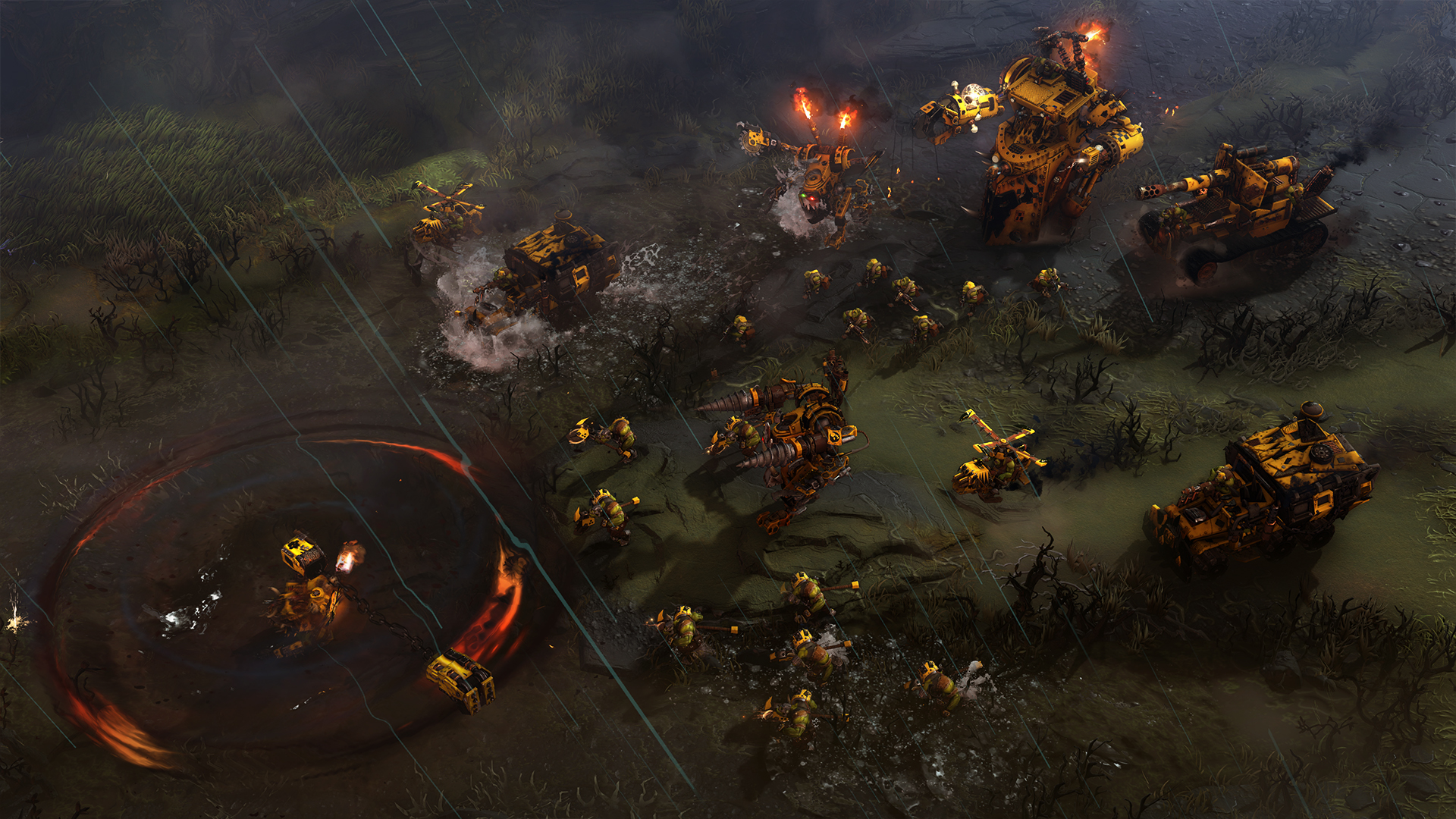
In multiplayer, though their speed gives them an edge, their hit and run attacks can also be undermined by smart opponents. Boulle offers up some tips for Space Marine players who find themselves dealing with the sneaky xenos, particularly when they’re being played by a devious human mind. Disrupting the flow of their attacks, the wave of assaults that pull back as quickly as they roll in should be the focus. The Space Marines’ plethora of knockback and stun attacks are important tools here, as is scouting to find the Gates—not just to destroy them, but to get an idea where the next attack may come from.
Compared to the Space Marines, the Eldar feel more complex. Trickier. Their red, armoured opponents are direct and unrelenting, while playing as the Eldar requires a lot more patience and control. The pay-off comes in perfectly timing an impressive attack—finding the right moment to unleash hell and charge in with the Wraithknight, activating its sword uppercut right when it reaches an enemy elite, and sending them hurtling away into the sky.
"I think they’re going to appeal to players who like to pull off a fantastic move," says Boulle. "It can require a little more finesse depending on your ability selection or unit selection than Space Marines, who tend to do OK if you leave them be. Eldar only come into their own when you’re making sure to use all their abilities. Players who like tricking the enemy into moving out of position, flanking, or pulling off the gate at the back of the base tactic... it should appeal to them."
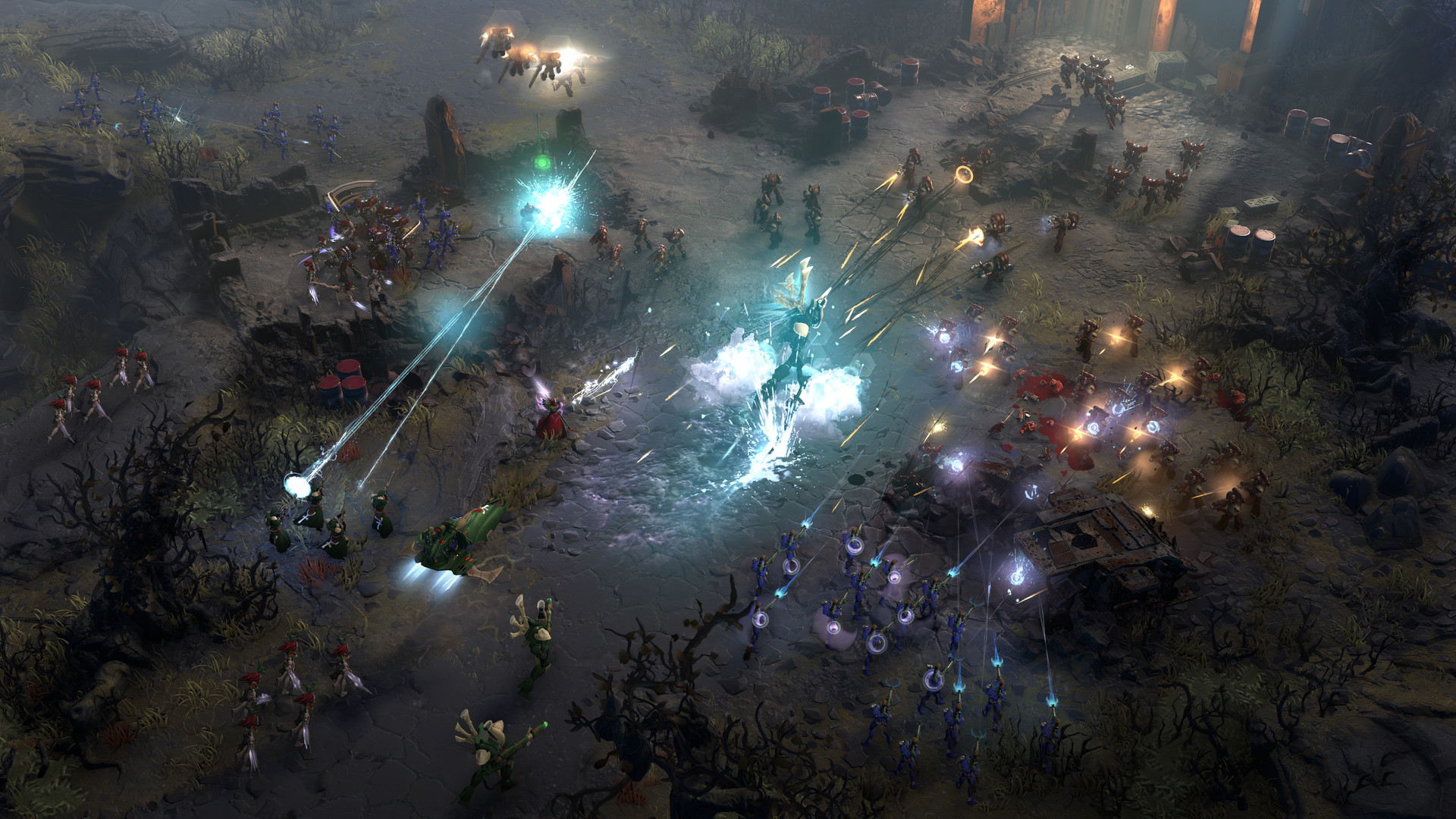
Not available in the Cyprus Prime mission were two of the Eldar’s most dreaded weapons: the Wraithknight super unit, who looks like an even bigger Taldeer, and the faction’s terrifying superweapon, their version of the Space Marine orbital cannon. The former is so huge that the screen shakes every time it plants one of its titanic, hoofed feet on the ground, and it can trap and then eradicate big groups of enemies with terrifyingly powerful guns. The latter summons an immense psychic storm that can damage and disrupt enemies, and it can also be attached to a unit, temporarily transforming it into the eye of an even deadlier storm. The area of effect is massive, and you definitely don’t want to get trapped inside it.
So while the Eldar might be fast and subtle, underneath that is almost unimaginable power, reflected by their top tier units and abilities. Killing enemies very quickly is the Eldar’s bag. And when you’re popping abilities left, right and centre, and tearing apart Space Marine after Space Marine, it feels like you’re taking part in a battle ripped straight out of some over-the- top concept art. It’s impressive.
"What we’re going for is the fantasy of the faction," Boulle explains after I finally send Gabriel Angelos packing. "So it’s not always a direct manifestation of the ruleset, it’s more this is how they’re portrayed in the fiction, this is how they’re portrayed in all the art. This is the fantasy that they represent."

Fraser is the UK online editor and has actually met The Internet in person. With over a decade of experience, he's been around the block a few times, serving as a freelancer, news editor and prolific reviewer. Strategy games have been a 30-year-long obsession, from tiny RTSs to sprawling political sims, and he never turns down the chance to rave about Total War or Crusader Kings. He's also been known to set up shop in the latest MMO and likes to wind down with an endlessly deep, systemic RPG. These days, when he's not editing, he can usually be found writing features that are 1,000 words too long or talking about his dog.

